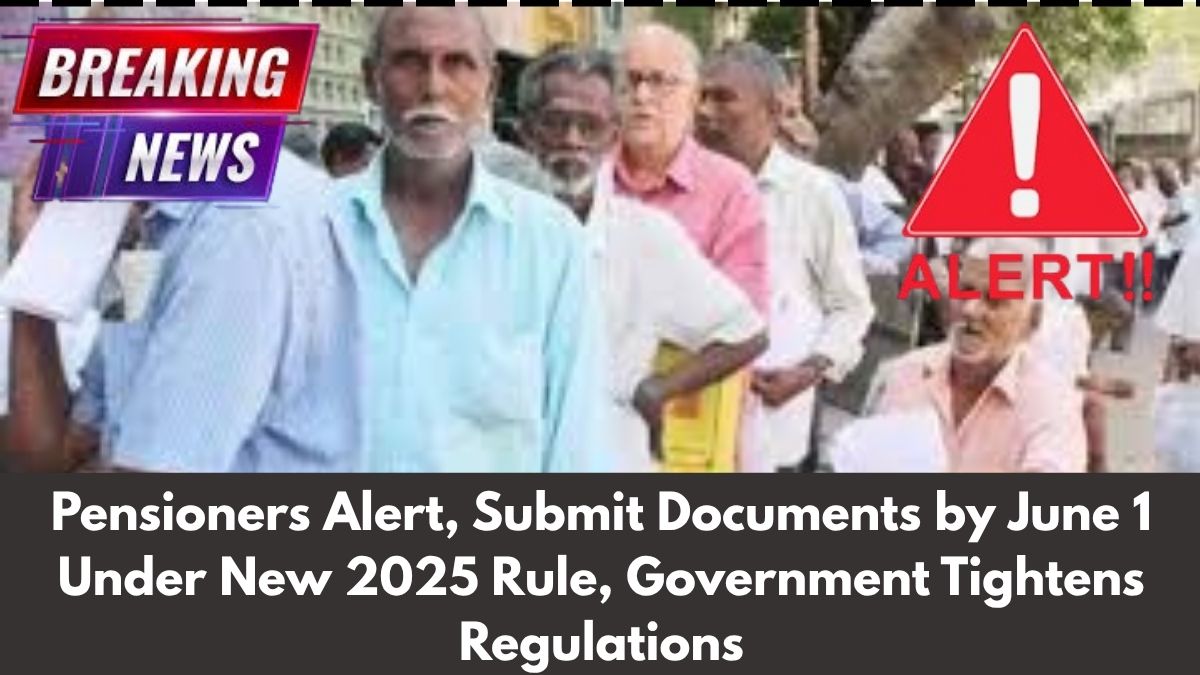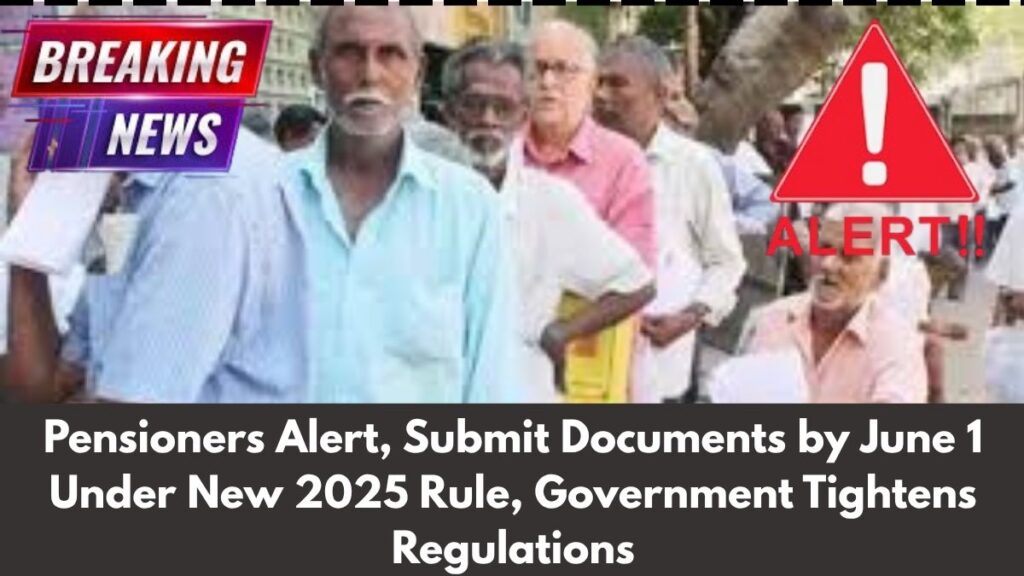In a landmark move aimed at modernizing and securing India’s pension system, the Government of India has introduced the “2025 Rule,” a comprehensive regulatory initiative that mandates all pensioners—regardless of their employment background—to submit essential documentation by June 1, 2025. This new directive is not just a bureaucratic formality; it’s a large-scale overhaul designed to bring pension services in line with digital governance standards, ensuring efficiency, transparency, and fraud prevention.
Failure to comply may lead to suspended or delayed pension payments, affecting the financial security of millions of retirees across the country. Whether you’re a retired government official, ex-serviceman, private sector retiree, or family pensioner, understanding and adhering to this rule is vital.

Summary of the 2025 Rule: Quick Overview
Aspect |
Details |
|---|---|
Policy Name |
2025 Rule for Pensioners |
Deadline |
June 1, 2025 |
Beneficiaries |
All pensioners (Government, Private, Defense, Family) |
Key Requirement |
Submission of verified documents |
Submission Options |
Online portal, post, facilitation centers, banks, agents |
Risk of Non-Compliance |
Delay or suspension of pension payments |
Support Helpline |
1800-123-4567 |
Official Portal |
Why the 2025 Rule Was Introduced
The 2025 Rule is the most significant pension-related reform in recent decades. Its objectives include:
-
Preventing pension fraud
-
Modernizing the pension infrastructure
-
Streamlining disbursement processes
-
Digitally integrating pension services
The initiative aligns with the broader Digital India campaign and seeks to address administrative inefficiencies that have long plagued the pension system.
Key Objectives of the 2025 Rule
Component |
Purpose |
Effect |
|---|---|---|
Document Modernization |
Ensure all records are current |
Eliminates errors |
Digital Integration |
Transition to digital records |
Enables faster processing |
Fraud Prevention |
Detect and stop illegal claims |
Saves public funds |
Administrative Efficiency |
Reduce processing delays |
Timely pensions |
Record Accuracy |
Ensure database updates |
Reliable payments |
Compliance Enforcement |
Enforce new standard |
System reliability |
Required Documentation and Their Purpose
To comply, pensioners must gather and submit the following documents:
Document |
Purpose |
Submission Type |
|---|---|---|
Aadhaar Card / PAN |
Verify identity |
Digital copy + original |
Recent Photograph |
Visual validation |
Physical + digital |
Bank Passbook |
Validate payment destination |
Certified copy |
PPO (Pension Payment Order) |
Confirm pension entitlement |
Official document |
Life Certificate |
Confirm continued eligibility |
Bank/Post Office certified |
Note: The Life Certificate is especially crucial—it cannot be notarized and must be obtained from an authorized institution.
Submission Options: Digital and Physical
Understanding the varied needs of pensioners, the government offers six submission methods:
Method |
Ideal For |
Advantages |
|---|---|---|
Online Portal |
Tech-savvy pensioners |
Fastest, 24/7 |
Local Offices |
Traditional users |
Face-to-face help |
Registered Post |
Rural pensioners |
No tech needed |
Agents |
Complex situations |
Guided help |
Bank/Post Offices |
Familiar setups |
Easy access |
Facilitation Centers |
New users |
Dedicated support |
This multi-channel approach ensures no pensioner is left behind, regardless of digital literacy or location.
Timeline and Action Plan for Compliance
Phase |
Action |
Goal |
|---|---|---|
Jan–Feb 2025 |
Gather documents |
Identify and fix errors early |
Mar–Apr 2025 |
Choose submission method |
Prepare all forms and copies |
Apr–May 2025 |
Submit documents |
Avoid deadline rush |
May–Jun 2025 |
Track and resolve issues |
Confirm successful submission |
Tip: Submit documents 2-3 weeks before June 1 to allow time for corrections if needed.
Benefits of the New Pension System
Benefit |
Details |
|---|---|
Faster Payments |
50% reduction in delays |
Accurate Disbursement |
Fewer errors in amount |
Real-Time Tracking |
Know your payment status |
Enhanced Security |
Reduced fraud risk |
Flexible Submission |
Multiple channels |
Digital Modernization |
Future-ready pension system |
Government Assistance Services
To ease the transition, several support systems are in place:
Service |
Details |
|---|---|
Helpline |
1800-123-4567 (Mon–Fri, 9 AM–6 PM) |
Online Portal |
|
Facilitation Centers |
Check local listings |
Post Office Help |
Available Mon–Sat |
Bank Help Desks |
Assistance during banking hours |
Mobile Units |
Scheduled visits in rural areas |
Common Issues and Solutions
Issue |
Cause |
Solution |
|---|---|---|
Missing Documents |
Incomplete personal files |
Start early, use checklist |
Online Errors |
Tech unfamiliarity |
Practice, use facilitation centers |
Conflicting Information |
Different data on documents |
Cross-verify all fields |
Late Submissions |
Procrastination |
Set calendar reminders |
Miscommunication |
Confusing instructions |
Rely on official sources only |
Avoiding these pitfalls is essential to secure uninterrupted pension benefits.
Looking Ahead: Future of India’s Pension Services
The 2025 Rule lays the foundation for long-term pension reform in India. Expected developments include:
-
Automated disbursement and updates
-
Integration with national ID systems
-
Enhanced fraud detection through AI
-
Real-time benefit recalculations
-
Unified pension dashboards
Pensioners who embrace digital tools now will be well-positioned to enjoy these future benefits.
For more details, always refer to the official government website:
www.pension.gov.in
Frequently Asked Questions (FAQs)
Q1. What documents are mandatory under the 2025 Rule?
A: Aadhaar or PAN card, a recent photograph, bank passbook, PPO copy, and a current Life Certificate.
Q2. Can I submit my documents online?
A: Yes, through www.pension.gov.in. It’s secure and accessible 24/7.
Q3. What if I miss the June 1, 2025 deadline?
A: Your pension may be delayed or suspended. It’s advised to submit documents 2–3 weeks early.
Q4. How can NRI pensioners comply with the 2025 Rule?
A: Use the online portal, send documents via international registered post, or appoint an authorized representative in India.
For More Information Click Here









